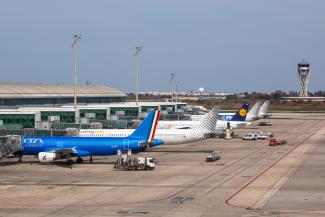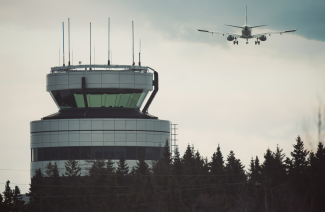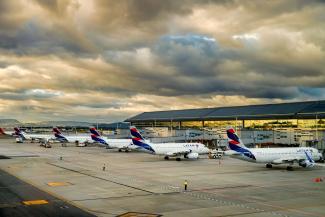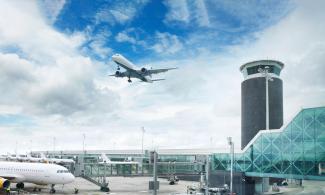In 2019, Latin America accounted for approximately 2.8% of the global air cargo market (measured in Freight Ton Kilometers or FTKs). Nevertheless, it consolidated its position as one of the fastest-growing markets with promising future prospects. It recorded the third-highest growth rate at 5.3%, increasing from 4,700 KTKs in 2010 to 7,500 FTKs in 2019 (pre-pandemic period). This growth was surpassed only by the Middle East and Central Asia.
The escalating demand for air traffic necessitated the development of new infrastructure to manage this increasing demand. This includes the construction of new terminal buildings to optimize processes throughout the air cargo transport value chain. Additionally, logistic centers have been established near airport perimeters, enabling the consolidation of all activities in a single space and facilitating the efficient handling of high cargo volumes.
Examples of these developments include the recently inaugurated Cargo City at Las Americas International Airport in Santo Domingo (Dominican Republic), managed by AERODOM, a subsidiary of the logistics giant VINCI. Another instance is the construction of a new terminal building in Porto Alegre (Brazil) by the airport's concessionaire, Fraport Brazil.

Source: AERODOM, LimaHub, AirCargo Latin America, Grupo Puntacana
More ambitious infrastructure projects in the region include the , a logistic center located near Lima Airport (Peru), which, together with the modern Lima Cargo City, forms one of the largest and most significant logistics complexes focused on air cargo in Latin America.
- Lima Cargo City operates over 18,000 m2 of built-up area for air cargo warehouses, along with 30,000 m2 of office space for the air freight sector.
- Lima Hub currently has approximately 13,000 m2 of warehouses.
- Within LAP facilities, the Southern Cargo Zone, currently under construction by IKSA (Lima Cargo City), encompasses 38,000 m2 for customs warehouses, air cargo storage facilities, and other support areas for airport operations.
Additionally, the Punta Cana Free Trade Zone is currently under construction, representing another noteworthy development in the region.

Lima Cargo City
These new developments, often associated with significant investments and capital expenses, have led to the establishment of novel management and operational models, including concessions to inmologistic agents responsible for overseeing the infrastructure assigned to them, acting as intermediaries between various cargo operators and the airport.
One of the most crucial aspects to consider in airport planning and all the aforementioned projects is the economic viability of proposed solutions. This viability can be constrained by the associated investment plan and phasing in most cases.
Traditionally, it has been the same airport operation the actor which has been responsible for the construction and expansion of the infrastructure so they can be later transferred to private cargo operators for their operation and maintenance (as in the case of cargo terminals) or maintaining the control and operating them by themselves (as in the case of passenger terminals).
In both scenarios, the airport operator bears the responsibility for managing the infrastructure, with varying degrees of involvement and accountability. This ranges from direct negotiations with cargo operators for the rental of each cargo module to full-scale management and governance.
With the progressive liberalization and increasing openness of the air transport market to foreign entities, a new model has emerged. In this model, the airport delegates the management and construction of certain infrastructure to an inmologistic agent in exchange for a fixed fee or rental of spaces, with an additional variable income based on financial performance. This inmologistic agent is entrusted with selecting private cargo operators.

Source: ALG Analisis
Nevertheless, in both this new case and those previously mentioned, the airport operator remains the body responsible for the supervision and control of the facilities, ensuring that agreed-upon levels of service and quality standards are met. In most cases where this model has been implemented, a win-win situation has been achieved for both parties involved.
For the airport operator, the loss of strategic power is offset by the absence of investment obligations, allowing them to allocate financial and personnel resources to the development of other systems and infrastructure. Meanwhile, they receive a constant income resulting in a stable and consistently positive cash flow. On the other hand, the inmologistic agent, with more experience and know-how in these operations, can likely achieve cost improvements associated with the construction or expansion of the facilities.
This management system has been successfully adopted by various airports, such as in El Salvador, where the company Alutech (a subsidiary of the EMCO Group) will be responsible for the modernization and expansion of the cargo terminal with a cumulative investment of over 62 million USD over 35 years. Similarly, this concept has facilitated the allocation by AENA of the first logistics area within Madrid-Barajas Airport to the company P3 Logistic Parks (controlled by the sovereign fund of the Government of Singapore). They commit to an investment of approximately 170 million EUR in exchange for 28 hectares of prime cargo land for development.

Source: AENA
Sources
- Boeing 202, World Air Cargo Forecast 2022–2041, accessed on 17 de marzo de 2023
- Banco Interamericano de Desarrollo 2022, El transporte de carga aérea en América Latina y el Caribe: análisis integral del sector y recomendaciones de políticas públicas, accessed on 17 March 2023
- DerechoYNegocios 2021, CEPA firma concesión de la terminal de carga del Aeropuerto San Óscar Romero, accessed on 17 March 2023
- El Mercantil 2022, Aena adjudica la primera área logística del polo Madrid-Barajas a la inmologística de Singapur, accessed on 17 March 2023
- AENA 2022, Aena adjudica la primera área logística de la Ciudad Aeroportuaria Adolfo Suárez Madrid-Barajas a P3 Group Sarl, cuyo proyecto supone un compromiso de cerca de 170 millones de euros, accessed on 17 March 2023
- Grupo Puntacana 2022, Punta Cana Free Trade Zone, accessed on 17 March 2023













































































